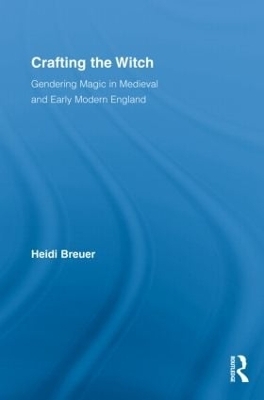
Crafting the Witch
Gendering Magic in Medieval and Early Modern England
Seiten
2009
Routledge (Verlag)
978-0-415-97761-6 (ISBN)
Routledge (Verlag)
978-0-415-97761-6 (ISBN)
How did the witch become wicked? This is the central question of Crafting the Witch, which documents and analyzes the gendered transformation of magical figures that occurred in Arthurian romance as it developed from its earliest continental manifestations in the twelfth century to its flowering in fifteenth- and sixteenth-century England.
This book analyzes the gendered transformation of magical figures occurring in Arthurian romance in England from the twelfth to the sixteenth centuries.
In the earlier texts, magic is predominantly a masculine pursuit, garnering its user prestige and power, but in the later texts, magic becomes a primarily feminine activity, one that marks its user as wicked and heretical. This project explores both the literary and the social motivations for this transformation, seeking an answer to the question, 'why did the witch become wicked?'
Heidi Breuer traverses both the medieval and early modern periods and considers the way in which the representation of literary witches interacted with the culture at large, ultimately arguing that a series of economic crises in the fourteenth century created a labour shortage met by women. As women moved into the previously male-dominated economy, literary backlash came in the form of the witch, and social backlash followed soon after in the form of Renaissance witch-hunting. The witch figure serves a similar function in modern American culture because late-industrial capitalism challenges gender conventions in similar ways as the economic crises of the medieval period.
This book analyzes the gendered transformation of magical figures occurring in Arthurian romance in England from the twelfth to the sixteenth centuries.
In the earlier texts, magic is predominantly a masculine pursuit, garnering its user prestige and power, but in the later texts, magic becomes a primarily feminine activity, one that marks its user as wicked and heretical. This project explores both the literary and the social motivations for this transformation, seeking an answer to the question, 'why did the witch become wicked?'
Heidi Breuer traverses both the medieval and early modern periods and considers the way in which the representation of literary witches interacted with the culture at large, ultimately arguing that a series of economic crises in the fourteenth century created a labour shortage met by women. As women moved into the previously male-dominated economy, literary backlash came in the form of the witch, and social backlash followed soon after in the form of Renaissance witch-hunting. The witch figure serves a similar function in modern American culture because late-industrial capitalism challenges gender conventions in similar ways as the economic crises of the medieval period.
Heidi Breuer is Associate Professor at California State University, San Marcos, USA.
Preface
Acknowledgments
Chapter One: "Are You a Good Witch or a Bad Witch?": An Introduction to Medieval and Early Modern Magic
Chapter Two: Gender-Blending: Transformative Power in Twelfth- and Thirteenth-Century Arthurian Literature
Chapter Three: From Rags to Riches, Or the Step-Mother’s Revenge: Transformative Power in Late Medieval Arthurian Romances
Chapter Four: The Lady is a Hag: Three Writers and the Transformation of Magic in Sixteenth-Century England
Chapter Five: Hags on Film: Contemporary Echoes of the Early Modern Wicked Witch
Notes
Bibliography
Index
| Erscheint lt. Verlag | 24.4.2009 |
|---|---|
| Reihe/Serie | Studies in Medieval History and Culture |
| Verlagsort | London |
| Sprache | englisch |
| Maße | 152 x 229 mm |
| Gewicht | 440 g |
| Themenwelt | Sachbuch/Ratgeber ► Gesundheit / Leben / Psychologie ► Esoterik / Spiritualität |
| Geschichte ► Allgemeine Geschichte ► Mittelalter | |
| Geisteswissenschaften ► Geschichte ► Regional- / Ländergeschichte | |
| Geisteswissenschaften ► Sprach- / Literaturwissenschaft ► Anglistik / Amerikanistik | |
| Geisteswissenschaften ► Sprach- / Literaturwissenschaft ► Literaturwissenschaft | |
| Sozialwissenschaften ► Ethnologie | |
| Sozialwissenschaften ► Soziologie | |
| ISBN-10 | 0-415-97761-4 / 0415977614 |
| ISBN-13 | 978-0-415-97761-6 / 9780415977616 |
| Zustand | Neuware |
| Haben Sie eine Frage zum Produkt? |
Mehr entdecken
aus dem Bereich
aus dem Bereich
eine neue Geschichte des Mittelalters
Buch | Hardcover (2023)
C.H.Beck (Verlag)
38,00 €


